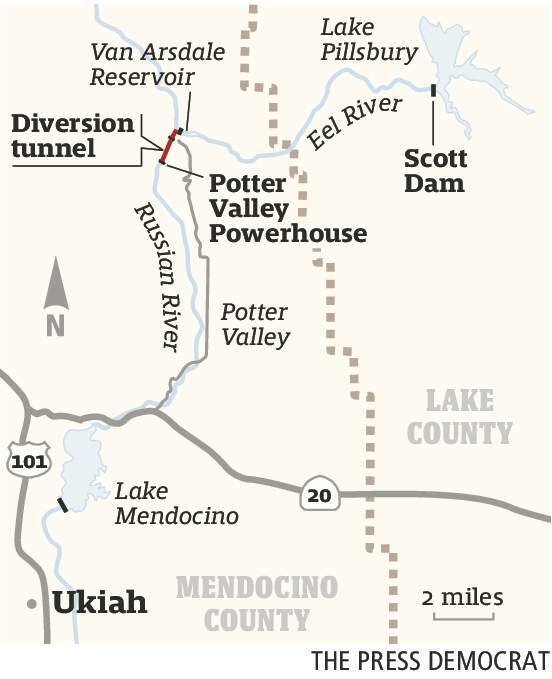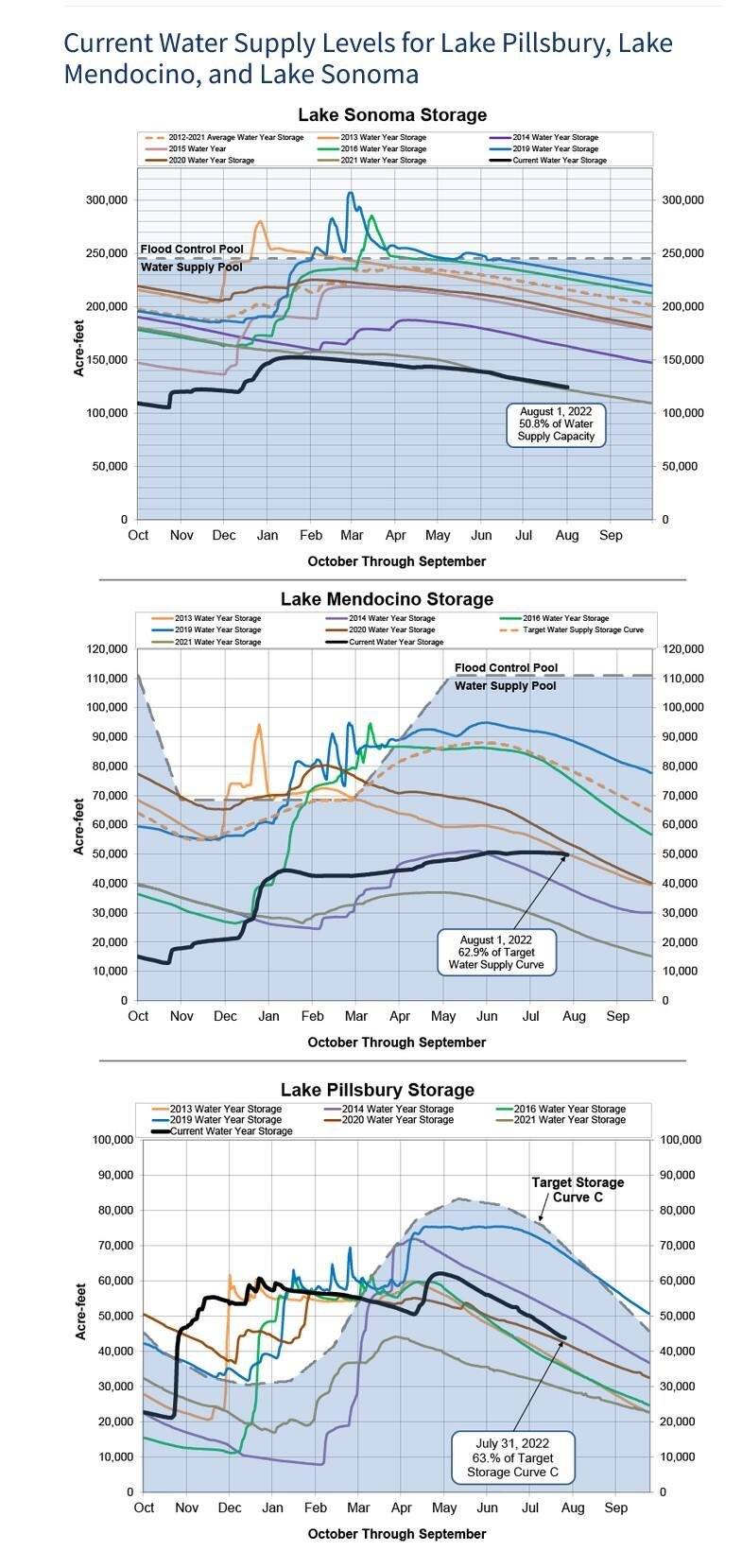THE PRESS DEMOCRAT
August 2, 2022, 4:58PM - Updated 2 hours ago
Federal energy regulators say Pacific Gas & Electric can begin drastically reducing Eel River water diversions bound for Lake Mendocino, which will likely result in additional curtailments of water rights for hundreds of landowners, ranchers and communities in the Russian River watershed.
The new flow regime, approved last week after more than two months of consideration by the Federal Energy Regulatory Commission, authorizes PG&E to divert as little water as it did last year even though there is almost 50% more water in Lake Pillsbury than there was at the same time last year.
But PG&E is under pressure from state and federal wildlife agencies to improve conditions for federally listed salmon and steelhead trout below Scott Dam and Lake Pillsbury and, thus, is seeking to preserve a pool of cold water in the lake for release when necessary to enable fish survival.
It also told regulators that allowing the reservoir to be drawn down too much risked bank sloughing and damage.
Urban water providers supplied by Sonoma Water, which has rights to water stored behind Coyote Dam, will still have the same access to water they had last year, Principal Engineer Don Seymour said.
The agency, which supplies more than 600,000 consumers through its retailers in Sonoma and northern Marin counties, has taken measures to conserve water in the lake, including a pledge to reduce withdrawals from 2020 levels by 20% from July 1 to Oct. 31.
But many of those who rely on water from the river and its tributaries can expect to lose the right to withdraw it for the time being. New orders from the State Water Resources Control Board are expected to come out Thursday or Friday suspending water rights of a still unknown number of rights holders in the watershed.
Though not unexpected, word of the reduced river flow is widely disappointing, said Robin Bartholow, deputy executive director of the Sonoma County Farm Bureau.
“It’s not good news,” said Isaul “Junior” Macias, vineyard manager at Hoot Owl Creek Vineyards in Alexander Valley.
The federal variance allows for about a 93% reduction in flows from the Eel River into East Fork Russian River and Lake Mendocino.
“It’s really a blow,” said Elizabeth Salomone, general manager of the Russian River Water Conservation and Flood Control District in Mendocino County.
Already, nearly 600 water rights in the upper and lower Russian River have been curtailed to ensure Lake Mendocino retains sufficient storage after a third year of drought.
Newly authorized efforts by PG&E to maintain a minimum threshold in Lake Pillsbury by throttling back downstream releases from the Eel River through the Potter Valley hydroelectric plant could mean additional curtailments on the scale of last year, at least in the upper watershed, said Philip Dutton, senior water resource control engineer with the state water board. The water board staff is still crunching the numbers, he said.
Potter Valley Powerhouse, map
Water fed through PG&E’s disabled power plant from the Eel River dumps into the East Fork Russian River and then into Lake Mendocino. Some of the resulting stream flow — up to 50 cubic feet per second under the new approval — is allocated to fulfill a contract with the Potter Valley Irrigation District.
About 5 cfs — down from around 75 cfs until now — is considered minimum in-stream flow required for environmental purposes. It’s that water and whatever return flows might accrue after the Potter Valley Irrigation District takes its allowance that is the only new water coming into Lake Mendocino at this point.
That water so far this year has kept the water level stable, said Nick Malasavage, chief of operations and readiness for the U.S. Army Corps of Engineers, San Francisco District, which oversees lakes Sonoma and Mendocino.
“We’re going to start to see the impact as the lakes starts to drop,” he said.
Water storage levels as of Aug. 1, 2022 in lakes Sonoma, Mendocino and Pillsbury. (Sonoma Water)
The lower flow also likely will mean the suspension, at least temporarily, of a groundbreaking voluntary water sharing agreement in use on the Russian River for the past month. It permitted participants with older, “senior” water rights that they were still allowed to exercise to share water allotments with those whose rights had been curtailed. temporarily, of a groundbreaking voluntary water sharing agreement in use on the Russian River for the past month. It permitted participants with older, “senior” water rights that they were still allowed to exercise to share water allotments with those whose rights had been curtailed.
There’s not expected to be enough water in the system now for at least some of those who had been sharing to supply even their own needs, water officials said.
Macias and Hoot Owl Creek Vineyards were among those who benefited from the water sharing after the vineyard’s water rights were among 331 curtailed in early July.
The program “went great,” he said, allowing him to see diminished acreage halfway through summer.
“Now,” he said, “going into the month of August — August, September, which are two crucial months for irrigating and getting the fruit ripe — that’s going to change everything.”
Bartholow said local agriculture stakeholders worked so hard over many months to frame the water sharing agreement with state water board personnel that to have it paused now “feels like it’s been undercut.”
“It’s just the variance (granted for stream flows) potentially made all that work moot,” Bartholow said. “The flip side of that is that this is a great model, working with the water board and the other agencies.”
Devon Jones, executive director of the Mendocino County Farm Bureau, said she hoped that conditions might allow for a bit more water in the system as time goes on, allowing more users to have access.
She said that some of those who face curtailment may have other water resources, such as storage ponds or recycled water, but the largest impact would fall on those with only one source: the river.
The curtailments allow for a minimum health and human safety allowance for those who live on land affected that she hoped would be extended for livestock.
You can reach Staff Writer Mary Callahan at 707-521-5249 or mary.callahan@pressdemocrat.com. On Twitter @MaryCallahanB.


